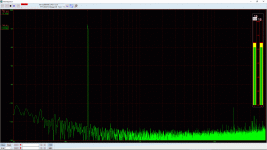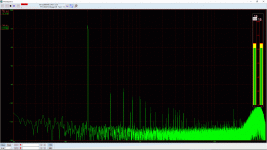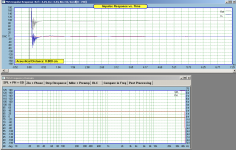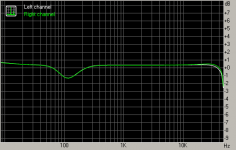I seem to recall that Win 7.1 was appreciably better.
The point is this: use WASAPI exclusive interface (Vista...Win10) if the SW support this... 😀
Hp
The point is this: use WASAPI exclusive interface (Vista...Win10) if the SW support this... 😀
Hp
WASAPI is greyed out on all my cards.
Scott- do you have a specific test that can confirm 24 bit accuracy? I'll try it with some options I have but I want a good way to verify the low bits.
I looked at waveforms and ratioed the step size to the min-max voltage and confirmed that was happening. Scott looked at the data directly.
From what I understand after discussion on jriver forum, 16bit contents are patched to the MSB to maintain same output level and input level full scale, so if the software is operating 16bit, then you get the 16bit step resolution. You never know if the software is playing tricks or whether the DAC is problematic. I also discovered that WinXP seems to only allow 16bit output. So a lot has to do with software. I am interested in this issue though, and will explore it some more.
1audio:
Verifying low bits may be accomplished many ways. In Cool Edit creating such test waveforms is straight forward:
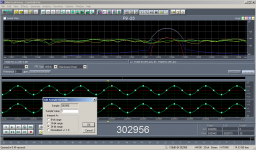
In above picture waveform is shown by alternating low bit for 24bit depth +/- 1, interspersed with 0 values to get 11025Hz sine wave with sample rate 44.1kHz. Waveform is looped back with JRiver playing output in one zone, and writing input to disk in another zone. Soundcard is E-MU 0404 USB with output max, and input gain at min. Process is repeated with low bit toggled for 16bit to generate 11025Hz sine.
Spectrum in above picture shows traces for test tracks and results. Clearly E-MU works as 24bit soundcard.
Spectrum of 24bit result with spectral averaging:
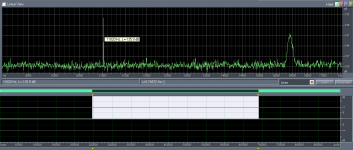
System is Windows 7 professional.
Soongsc:
I have produced identical results with WinXP professional.
Verifying low bits may be accomplished many ways. In Cool Edit creating such test waveforms is straight forward:

In above picture waveform is shown by alternating low bit for 24bit depth +/- 1, interspersed with 0 values to get 11025Hz sine wave with sample rate 44.1kHz. Waveform is looped back with JRiver playing output in one zone, and writing input to disk in another zone. Soundcard is E-MU 0404 USB with output max, and input gain at min. Process is repeated with low bit toggled for 16bit to generate 11025Hz sine.
Spectrum in above picture shows traces for test tracks and results. Clearly E-MU works as 24bit soundcard.
Spectrum of 24bit result with spectral averaging:

System is Windows 7 professional.
Soongsc:
I have produced identical results with WinXP professional.
I have produced identical results with WinXP professional.
That's were I started, my EMU 0204 worked fine under WinXP as did my Edirol UA5 10yr. ago.
I guess I could try JRiver demo and see, two instances of CoolEdit does not work for me under Win7, record instance is rail to rail garbage.
EDIT I'm slightly confused by your plots, usually there is no problem playing 24 bit data. Your first plot looks like the data you are sending to the DAC. Audacity for sure and Goldwave (it seems) do not record 24 bit data with any sound card (WASAPI a possible exception).
EDIT-EDIT Sorry I didn't see all the top traces in first plot.
Last edited:
Since my day job requires regular audio monitoring and A/B comparisons a high quality IEM and DAC are part of the work kit. I also game online and recently picked up a USB Creative Sound Blaster E5 hoping to hit both with one device.
Consider these results as provisional because they seem too good to be true but the spectrum capture below was taken with a 6" unshielded jumper directly from headphone output to line input. The SB software has 'direct out' enabled.. The latter reads like an ASIO function and bypasses the internal effects DSP. The spectrum is a mess when direct isn't enabled, even with the DSP presumably bypassed. That spectrum also included.
Tech notes: interfaces are set to 24/96, software is Wavespectra, weighting Harris-Blackman 7 term, input level -20 dBfs, output -15 dBfs which is in the range of best performance.
Consider these results as provisional because they seem too good to be true but the spectrum capture below was taken with a 6" unshielded jumper directly from headphone output to line input. The SB software has 'direct out' enabled.. The latter reads like an ASIO function and bypasses the internal effects DSP. The spectrum is a mess when direct isn't enabled, even with the DSP presumably bypassed. That spectrum also included.
Tech notes: interfaces are set to 24/96, software is Wavespectra, weighting Harris-Blackman 7 term, input level -20 dBfs, output -15 dBfs which is in the range of best performance.
Attachments
Hi rdf, have you had a chance to put the E5 through its paces in more detail? If it is true, it does look tempting...Consider these results as provisional because they seem too good to be true
Cheers,
Cabirio
Hi Cabirio, anything in particular you want to see? I'm limited to a software sine generator and Wavespectra right now. RMAA might be an option but I've never been 100% convinced by its results.
Hi rdf, thanks for your reply. From what you said I gathered that you might make some more tests to confirm. I'm thinking about a new measurement setup and I was waiting for either QA401 or JensH's, but the ETAs are unknown so in the meantime I thought I could get a good USB sound card that I can also use as such if in the end I get a dedicated audio analyzer.
This page does scare me a little about RMAA. I can't seem to find Wavespectra, do you have a link? Some other options I've been considering are a Picoscope 4262, only 16-bit but you get a proper oscilloscope and reportedly very nice software, or get a cheap Virtins 8-bit oscilloscope which includes the MI software, also said to be good and, unlike Picoscope's, capable of working with sound cards of other brands.
Cheers,
Cabirio
This page does scare me a little about RMAA. I can't seem to find Wavespectra, do you have a link? Some other options I've been considering are a Picoscope 4262, only 16-bit but you get a proper oscilloscope and reportedly very nice software, or get a cheap Virtins 8-bit oscilloscope which includes the MI software, also said to be good and, unlike Picoscope's, capable of working with sound cards of other brands.
Cheers,
Cabirio
Hi rdf, thanks for your reply. From what you said I gathered that you might make some more tests to confirm. I'm thinking about a new measurement setup and I was waiting for either QA401 or JensH's, but the ETAs are unknown so in the meantime I thought I could get a good USB sound card that I can also use as such if in the end I get a dedicated audio analyzer.
This page does scare me a little about RMAA. I can't seem to find Wavespectra, do you have a link? Some other options I've been considering are a Picoscope 4262, only 16-bit but you get a proper oscilloscope and reportedly very nice software, or get a cheap Virtins 8-bit oscilloscope which includes the MI software, also said to be good and, unlike Picoscope's, capable of working with sound cards of other brands.
IME NWAVGuy's comments about the Audio Rightmark are about 100% correct, but a lot of the so called problems come with the territory and apply to just about any product to some degree or the other.
For example:
"SETUP IS EVERYTHING: With RMAA there are many things to get wrong. Examples include hidden mixer controls, sound processing settings in the PC sound driver, sample rate conversion by the operating system or sound hardware, level settings—both at the PC and for the device being tested, loading, ground loops, cabling, etc. And if you’re doing loopback testing, you have no way of knowing what performance is related to the A/D, the D/A, or both. Even having a cell phone nearby can corrupt RMAA measurements with no error indication at all—just erroneous measurements. RMAA testing has lots of “blind” aspects that users are often unaware of. It has very poor internal consistency and error checking. Instead of giving a warning something might be wrong, it more often just produces false results.
"
Applies to every product in this category including the author's preferred software.
The thing to avoid is paralysis by means of analysis. Some practical real world experience will go a long way towards teaching you what you need to know.
The good thing about the Audio Rightmark is that it is free and is a good platform for getting your hands dirty. Like every other tool, just don't take its results for 100% gospel truth.
Last edited:
I can't seem to find Wavespectra, do you have a link?
I found this link as the original website is no longer available.. https://web.archive.org/web/20130517101420/http://www.ne.jp/asahi/fa/efu/soft/ws/WS151.ZIP
IME NWAVGuy's comments about the Audio Rightmark are about 100% correct, but a lot of the so called problems come with the territory and apply to just about any product to some degree or the other.
For example:
"SETUP IS EVERYTHING: With RMAA there are many things to get wrong. Examples include hidden mixer controls, sound processing settings in the PC sound driver, sample rate conversion by the operating system or sound hardware, level settings—both at the PC and for the device being tested, loading, ground loops, cabling, etc. And if you’re doing loopback testing, you have no way of knowing what performance is related to the A/D, the D/A, or both. Even having a cell phone nearby can corrupt RMAA measurements with no error indication at all—just erroneous measurements. RMAA testing has lots of “blind” aspects that users are often unaware of. It has very poor internal consistency and error checking. Instead of giving a warning something might be wrong, it more often just produces false results.
"
Applies to every product in this category including the author's preferred software.
The thing to avoid is paralysis by means of analysis. Some practical real world experience will go a long way towards teaching you what you need to know.
The good thing about the Audio Rightmark is that it is free and is a good platform for getting your hands dirty. Like every other tool, just don't take its results for 100% gospel truth.
Makes one think on of how long is a second, really - how many electrons need to pass 1 ohm before we have 1 ampere if we for certain knew the length of a second or could for certain count the electrons passing. The uncertainties make us strive - long live the uncertainties 😀
Regards
Some update on this. The older Xonar U7 had different firmware. I sent mine in for service because it started to not get recognised as a USB 2.0 device. They gave me a different unit which had new firmware which also allows it to be used for 24/192 playback on the mac. After testing using RMAA6, it does go up to 24/96 full duplex. When I tried 24/192, it would still give me bandwidth of 24/96. I then did a loop back using SoundEasy 2 channel scope, the sine waves were stable but the display was flickering, so I am not sure whether it is just a display speed issue since I was running Bootcamp on a mid 2010 MacBook Pro.I have only been able to get 16bit/96KHz measurements out of this card. The cards need to be able to run full duplex, which few cards specify.
For listening, I found the sound quality quite superb for the price. I have used M-audio TRANSIT, Meridian Explorer, PCMCIA devices like Echo Indigo io, a two Creative cards. The XONAR U7 is among the best running pretty close to the Meridian Explorer (with the right cable) when you get the right USB cable in there. Generally 30cm USB cable, thicker and stiffer, shielded type (not flat). The cable I found best was the Benevo.
Many thanks mcandmar, I'll check it out.I found this link as the original website is no longer available.. https://web.archive.org/web/20130517101420/http://www.ne.jp/asahi/fa/efu/soft/ws/WS151.ZIP
Cabirio
Many thanks mcandmar, I'll check it out.
Cabirio
Hi cabirio, sorry about the delay. Work intrudes...
Wavespectra is available here: WaveSpectra The site is in Japanese but the links are obvious.
We run a 24-bit audio-over-IP network at work. My desktop interface to the network is a software emulated sound card. The spectra displayed by Wavespectra of a software generated sine wave - so no AD, DA or essentially any audio hardware in the loop - is a near perfect spike to the noise floor, -130 to -140 by memory. I'm pretty comfortable with its results.
I could not find the download link for WaveSpectra, and it seems to work for WinXP and earlier?
Last edited:
Seems like the Xonar U7 is usable for some measurements.Some update on this. The older Xonar U7 had different firmware. I sent mine in for service because it started to not get recognised as a USB 2.0 device. They gave me a different unit which had new firmware which also allows it to be used for 24/192 playback on the mac. After testing using RMAA6, it does go up to 24/96 full duplex. When I tried 24/192, it would still give me bandwidth of 24/96. I then did a loop back using SoundEasy 2 channel scope, the sine waves were stable but the display was flickering, so I am not sure whether it is just a display speed issue since I was running Bootcamp on a mid 2010 MacBook Pro.
Attachments
- Status
- Not open for further replies.
- Home
- Design & Build
- Equipment & Tools
- USB sound card for audio spectrum analysis
